Fair Work Commission and Employment Relations: Oaky Creek Case Study
VerifiedAdded on 2021/06/17
|12
|3281
|182
Report
AI Summary
This report provides an in-depth analysis of the employment relations case involving Oaky Creek Coal Mine, focusing on the industrial dispute between the company and the Construction, Forestry, Mining and Energy Union (CFMEU). The case revolves around issues of collective bargaining, workplace fairness, and the role of the Fair Work Commission (FWC). The analysis examines the actions of both parties, including the company's response to industrial action and the union's efforts to protect employee rights. The report highlights the FWC's role in resolving the dispute, emphasizing its mandate to ensure fair treatment and promote cooperative relations in the workplace. The findings underscore the significance of the case in setting precedents for employment relations and the importance of upholding employee rights. Recommendations are provided for future cases and the report is available on Desklib, a platform that offers AI-powered study tools for students.
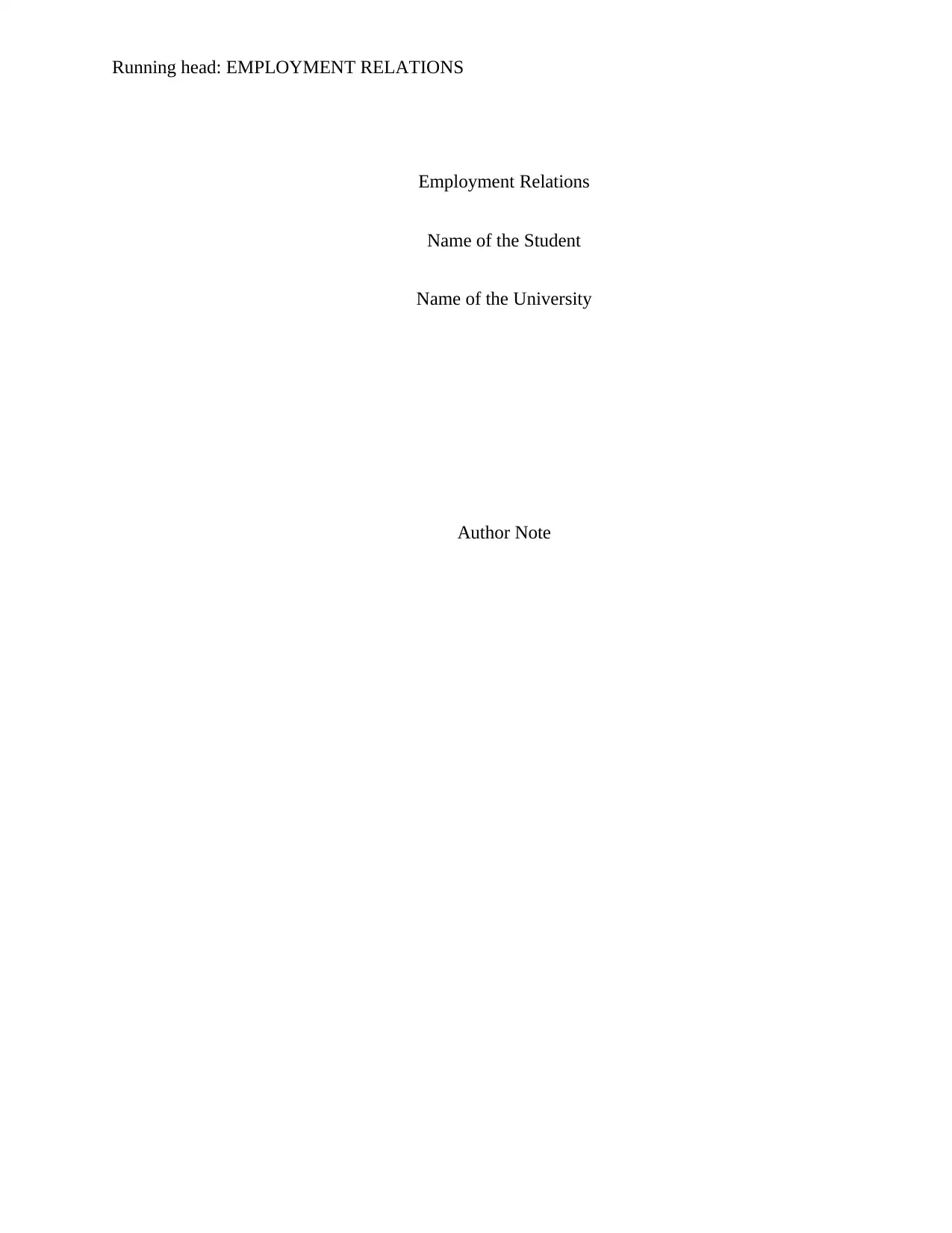
Running head: EMPLOYMENT RELATIONS
Employment Relations
Name of the Student
Name of the University
Author Note
Employment Relations
Name of the Student
Name of the University
Author Note
Paraphrase This Document
Need a fresh take? Get an instant paraphrase of this document with our AI Paraphraser
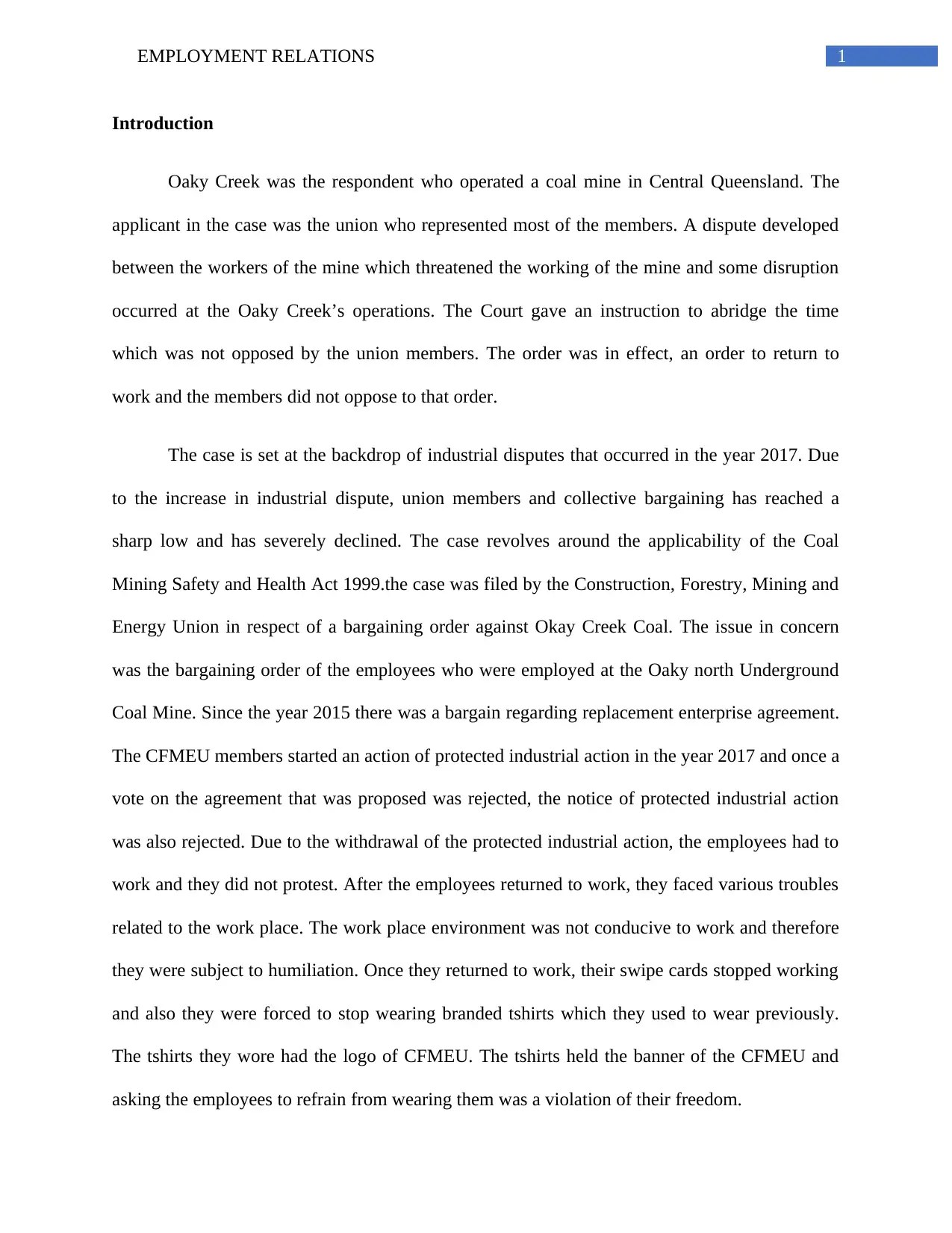
1EMPLOYMENT RELATIONS
Introduction
Oaky Creek was the respondent who operated a coal mine in Central Queensland. The
applicant in the case was the union who represented most of the members. A dispute developed
between the workers of the mine which threatened the working of the mine and some disruption
occurred at the Oaky Creek’s operations. The Court gave an instruction to abridge the time
which was not opposed by the union members. The order was in effect, an order to return to
work and the members did not oppose to that order.
The case is set at the backdrop of industrial disputes that occurred in the year 2017. Due
to the increase in industrial dispute, union members and collective bargaining has reached a
sharp low and has severely declined. The case revolves around the applicability of the Coal
Mining Safety and Health Act 1999.the case was filed by the Construction, Forestry, Mining and
Energy Union in respect of a bargaining order against Okay Creek Coal. The issue in concern
was the bargaining order of the employees who were employed at the Oaky north Underground
Coal Mine. Since the year 2015 there was a bargain regarding replacement enterprise agreement.
The CFMEU members started an action of protected industrial action in the year 2017 and once a
vote on the agreement that was proposed was rejected, the notice of protected industrial action
was also rejected. Due to the withdrawal of the protected industrial action, the employees had to
work and they did not protest. After the employees returned to work, they faced various troubles
related to the work place. The work place environment was not conducive to work and therefore
they were subject to humiliation. Once they returned to work, their swipe cards stopped working
and also they were forced to stop wearing branded tshirts which they used to wear previously.
The tshirts they wore had the logo of CFMEU. The tshirts held the banner of the CFMEU and
asking the employees to refrain from wearing them was a violation of their freedom.
Introduction
Oaky Creek was the respondent who operated a coal mine in Central Queensland. The
applicant in the case was the union who represented most of the members. A dispute developed
between the workers of the mine which threatened the working of the mine and some disruption
occurred at the Oaky Creek’s operations. The Court gave an instruction to abridge the time
which was not opposed by the union members. The order was in effect, an order to return to
work and the members did not oppose to that order.
The case is set at the backdrop of industrial disputes that occurred in the year 2017. Due
to the increase in industrial dispute, union members and collective bargaining has reached a
sharp low and has severely declined. The case revolves around the applicability of the Coal
Mining Safety and Health Act 1999.the case was filed by the Construction, Forestry, Mining and
Energy Union in respect of a bargaining order against Okay Creek Coal. The issue in concern
was the bargaining order of the employees who were employed at the Oaky north Underground
Coal Mine. Since the year 2015 there was a bargain regarding replacement enterprise agreement.
The CFMEU members started an action of protected industrial action in the year 2017 and once a
vote on the agreement that was proposed was rejected, the notice of protected industrial action
was also rejected. Due to the withdrawal of the protected industrial action, the employees had to
work and they did not protest. After the employees returned to work, they faced various troubles
related to the work place. The work place environment was not conducive to work and therefore
they were subject to humiliation. Once they returned to work, their swipe cards stopped working
and also they were forced to stop wearing branded tshirts which they used to wear previously.
The tshirts they wore had the logo of CFMEU. The tshirts held the banner of the CFMEU and
asking the employees to refrain from wearing them was a violation of their freedom.
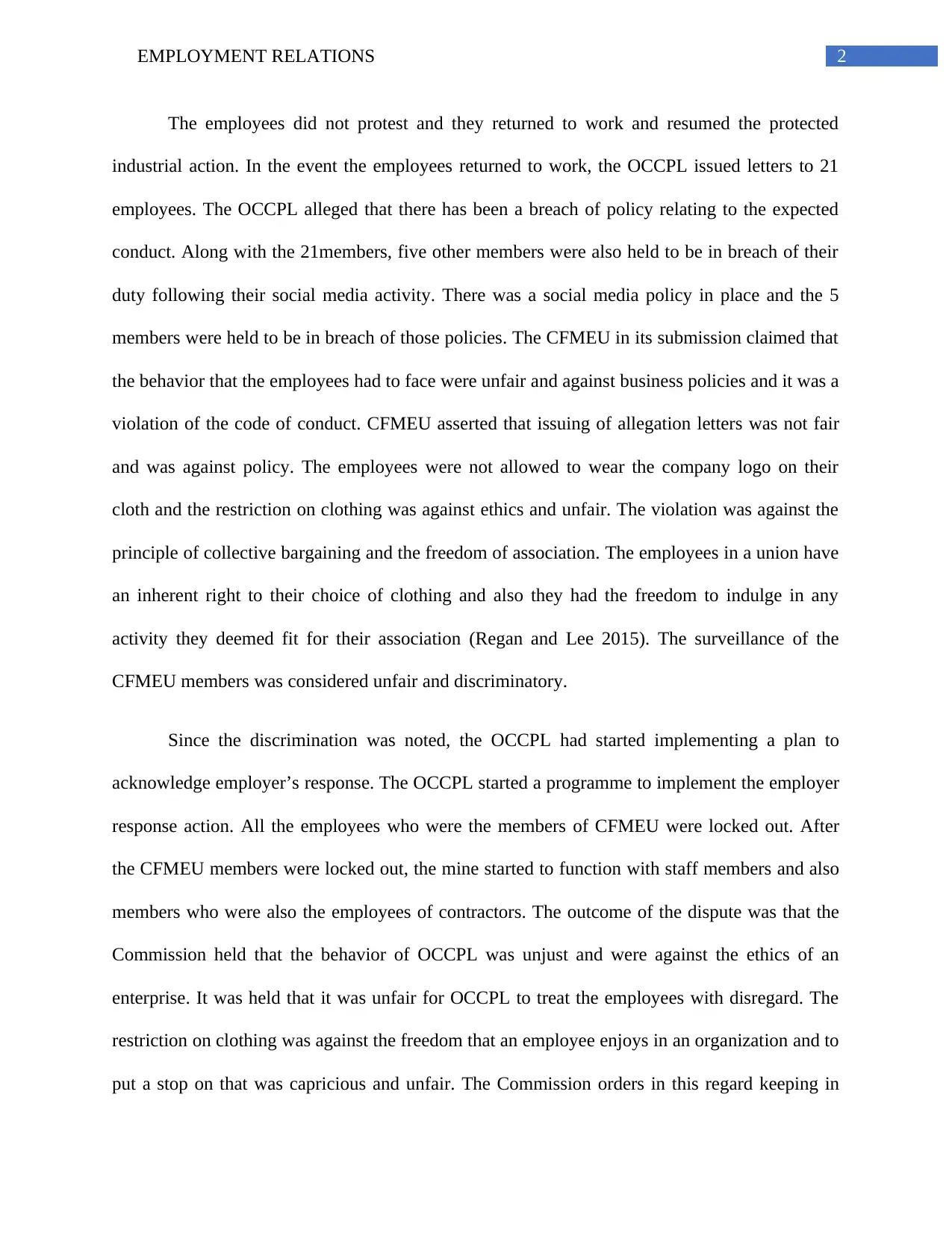
2EMPLOYMENT RELATIONS
The employees did not protest and they returned to work and resumed the protected
industrial action. In the event the employees returned to work, the OCCPL issued letters to 21
employees. The OCCPL alleged that there has been a breach of policy relating to the expected
conduct. Along with the 21members, five other members were also held to be in breach of their
duty following their social media activity. There was a social media policy in place and the 5
members were held to be in breach of those policies. The CFMEU in its submission claimed that
the behavior that the employees had to face were unfair and against business policies and it was a
violation of the code of conduct. CFMEU asserted that issuing of allegation letters was not fair
and was against policy. The employees were not allowed to wear the company logo on their
cloth and the restriction on clothing was against ethics and unfair. The violation was against the
principle of collective bargaining and the freedom of association. The employees in a union have
an inherent right to their choice of clothing and also they had the freedom to indulge in any
activity they deemed fit for their association (Regan and Lee 2015). The surveillance of the
CFMEU members was considered unfair and discriminatory.
Since the discrimination was noted, the OCCPL had started implementing a plan to
acknowledge employer’s response. The OCCPL started a programme to implement the employer
response action. All the employees who were the members of CFMEU were locked out. After
the CFMEU members were locked out, the mine started to function with staff members and also
members who were also the employees of contractors. The outcome of the dispute was that the
Commission held that the behavior of OCCPL was unjust and were against the ethics of an
enterprise. It was held that it was unfair for OCCPL to treat the employees with disregard. The
restriction on clothing was against the freedom that an employee enjoys in an organization and to
put a stop on that was capricious and unfair. The Commission orders in this regard keeping in
The employees did not protest and they returned to work and resumed the protected
industrial action. In the event the employees returned to work, the OCCPL issued letters to 21
employees. The OCCPL alleged that there has been a breach of policy relating to the expected
conduct. Along with the 21members, five other members were also held to be in breach of their
duty following their social media activity. There was a social media policy in place and the 5
members were held to be in breach of those policies. The CFMEU in its submission claimed that
the behavior that the employees had to face were unfair and against business policies and it was a
violation of the code of conduct. CFMEU asserted that issuing of allegation letters was not fair
and was against policy. The employees were not allowed to wear the company logo on their
cloth and the restriction on clothing was against ethics and unfair. The violation was against the
principle of collective bargaining and the freedom of association. The employees in a union have
an inherent right to their choice of clothing and also they had the freedom to indulge in any
activity they deemed fit for their association (Regan and Lee 2015). The surveillance of the
CFMEU members was considered unfair and discriminatory.
Since the discrimination was noted, the OCCPL had started implementing a plan to
acknowledge employer’s response. The OCCPL started a programme to implement the employer
response action. All the employees who were the members of CFMEU were locked out. After
the CFMEU members were locked out, the mine started to function with staff members and also
members who were also the employees of contractors. The outcome of the dispute was that the
Commission held that the behavior of OCCPL was unjust and were against the ethics of an
enterprise. It was held that it was unfair for OCCPL to treat the employees with disregard. The
restriction on clothing was against the freedom that an employee enjoys in an organization and to
put a stop on that was capricious and unfair. The Commission orders in this regard keeping in
⊘ This is a preview!⊘
Do you want full access?
Subscribe today to unlock all pages.

Trusted by 1+ million students worldwide
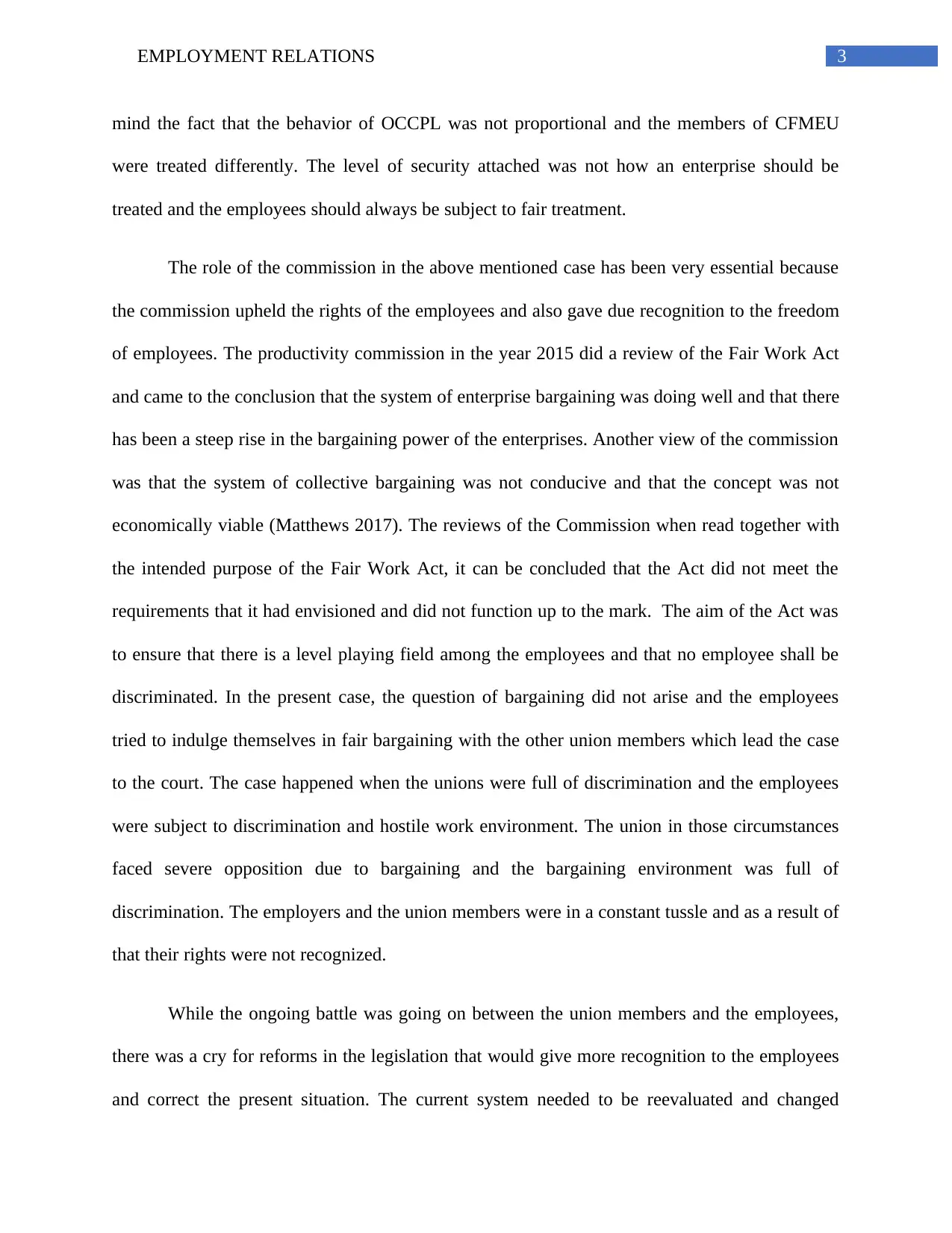
3EMPLOYMENT RELATIONS
mind the fact that the behavior of OCCPL was not proportional and the members of CFMEU
were treated differently. The level of security attached was not how an enterprise should be
treated and the employees should always be subject to fair treatment.
The role of the commission in the above mentioned case has been very essential because
the commission upheld the rights of the employees and also gave due recognition to the freedom
of employees. The productivity commission in the year 2015 did a review of the Fair Work Act
and came to the conclusion that the system of enterprise bargaining was doing well and that there
has been a steep rise in the bargaining power of the enterprises. Another view of the commission
was that the system of collective bargaining was not conducive and that the concept was not
economically viable (Matthews 2017). The reviews of the Commission when read together with
the intended purpose of the Fair Work Act, it can be concluded that the Act did not meet the
requirements that it had envisioned and did not function up to the mark. The aim of the Act was
to ensure that there is a level playing field among the employees and that no employee shall be
discriminated. In the present case, the question of bargaining did not arise and the employees
tried to indulge themselves in fair bargaining with the other union members which lead the case
to the court. The case happened when the unions were full of discrimination and the employees
were subject to discrimination and hostile work environment. The union in those circumstances
faced severe opposition due to bargaining and the bargaining environment was full of
discrimination. The employers and the union members were in a constant tussle and as a result of
that their rights were not recognized.
While the ongoing battle was going on between the union members and the employees,
there was a cry for reforms in the legislation that would give more recognition to the employees
and correct the present situation. The current system needed to be reevaluated and changed
mind the fact that the behavior of OCCPL was not proportional and the members of CFMEU
were treated differently. The level of security attached was not how an enterprise should be
treated and the employees should always be subject to fair treatment.
The role of the commission in the above mentioned case has been very essential because
the commission upheld the rights of the employees and also gave due recognition to the freedom
of employees. The productivity commission in the year 2015 did a review of the Fair Work Act
and came to the conclusion that the system of enterprise bargaining was doing well and that there
has been a steep rise in the bargaining power of the enterprises. Another view of the commission
was that the system of collective bargaining was not conducive and that the concept was not
economically viable (Matthews 2017). The reviews of the Commission when read together with
the intended purpose of the Fair Work Act, it can be concluded that the Act did not meet the
requirements that it had envisioned and did not function up to the mark. The aim of the Act was
to ensure that there is a level playing field among the employees and that no employee shall be
discriminated. In the present case, the question of bargaining did not arise and the employees
tried to indulge themselves in fair bargaining with the other union members which lead the case
to the court. The case happened when the unions were full of discrimination and the employees
were subject to discrimination and hostile work environment. The union in those circumstances
faced severe opposition due to bargaining and the bargaining environment was full of
discrimination. The employers and the union members were in a constant tussle and as a result of
that their rights were not recognized.
While the ongoing battle was going on between the union members and the employees,
there was a cry for reforms in the legislation that would give more recognition to the employees
and correct the present situation. The current system needed to be reevaluated and changed
Paraphrase This Document
Need a fresh take? Get an instant paraphrase of this document with our AI Paraphraser
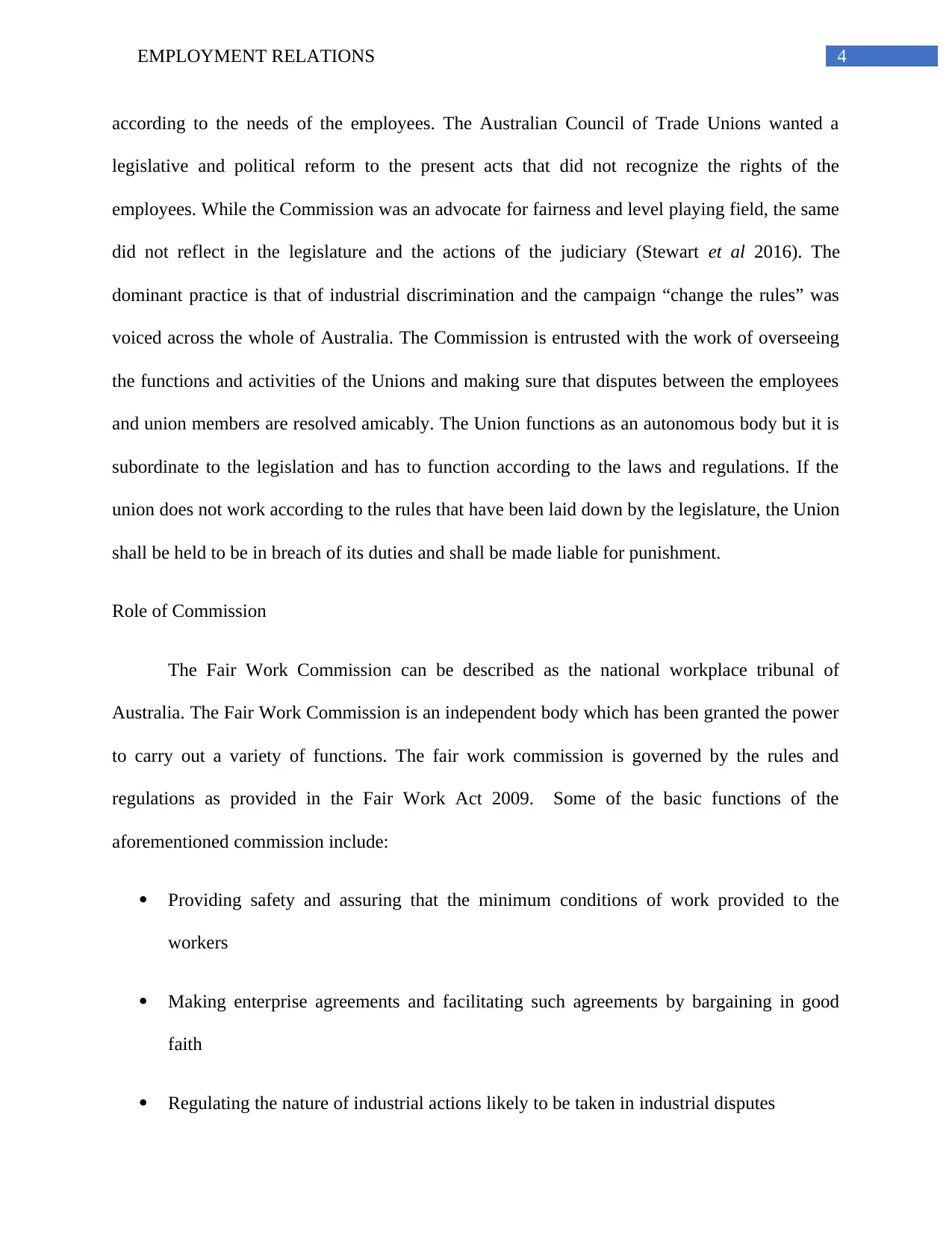
4EMPLOYMENT RELATIONS
according to the needs of the employees. The Australian Council of Trade Unions wanted a
legislative and political reform to the present acts that did not recognize the rights of the
employees. While the Commission was an advocate for fairness and level playing field, the same
did not reflect in the legislature and the actions of the judiciary (Stewart et al 2016). The
dominant practice is that of industrial discrimination and the campaign “change the rules” was
voiced across the whole of Australia. The Commission is entrusted with the work of overseeing
the functions and activities of the Unions and making sure that disputes between the employees
and union members are resolved amicably. The Union functions as an autonomous body but it is
subordinate to the legislation and has to function according to the laws and regulations. If the
union does not work according to the rules that have been laid down by the legislature, the Union
shall be held to be in breach of its duties and shall be made liable for punishment.
Role of Commission
The Fair Work Commission can be described as the national workplace tribunal of
Australia. The Fair Work Commission is an independent body which has been granted the power
to carry out a variety of functions. The fair work commission is governed by the rules and
regulations as provided in the Fair Work Act 2009. Some of the basic functions of the
aforementioned commission include:
Providing safety and assuring that the minimum conditions of work provided to the
workers
Making enterprise agreements and facilitating such agreements by bargaining in good
faith
Regulating the nature of industrial actions likely to be taken in industrial disputes
according to the needs of the employees. The Australian Council of Trade Unions wanted a
legislative and political reform to the present acts that did not recognize the rights of the
employees. While the Commission was an advocate for fairness and level playing field, the same
did not reflect in the legislature and the actions of the judiciary (Stewart et al 2016). The
dominant practice is that of industrial discrimination and the campaign “change the rules” was
voiced across the whole of Australia. The Commission is entrusted with the work of overseeing
the functions and activities of the Unions and making sure that disputes between the employees
and union members are resolved amicably. The Union functions as an autonomous body but it is
subordinate to the legislation and has to function according to the laws and regulations. If the
union does not work according to the rules that have been laid down by the legislature, the Union
shall be held to be in breach of its duties and shall be made liable for punishment.
Role of Commission
The Fair Work Commission can be described as the national workplace tribunal of
Australia. The Fair Work Commission is an independent body which has been granted the power
to carry out a variety of functions. The fair work commission is governed by the rules and
regulations as provided in the Fair Work Act 2009. Some of the basic functions of the
aforementioned commission include:
Providing safety and assuring that the minimum conditions of work provided to the
workers
Making enterprise agreements and facilitating such agreements by bargaining in good
faith
Regulating the nature of industrial actions likely to be taken in industrial disputes
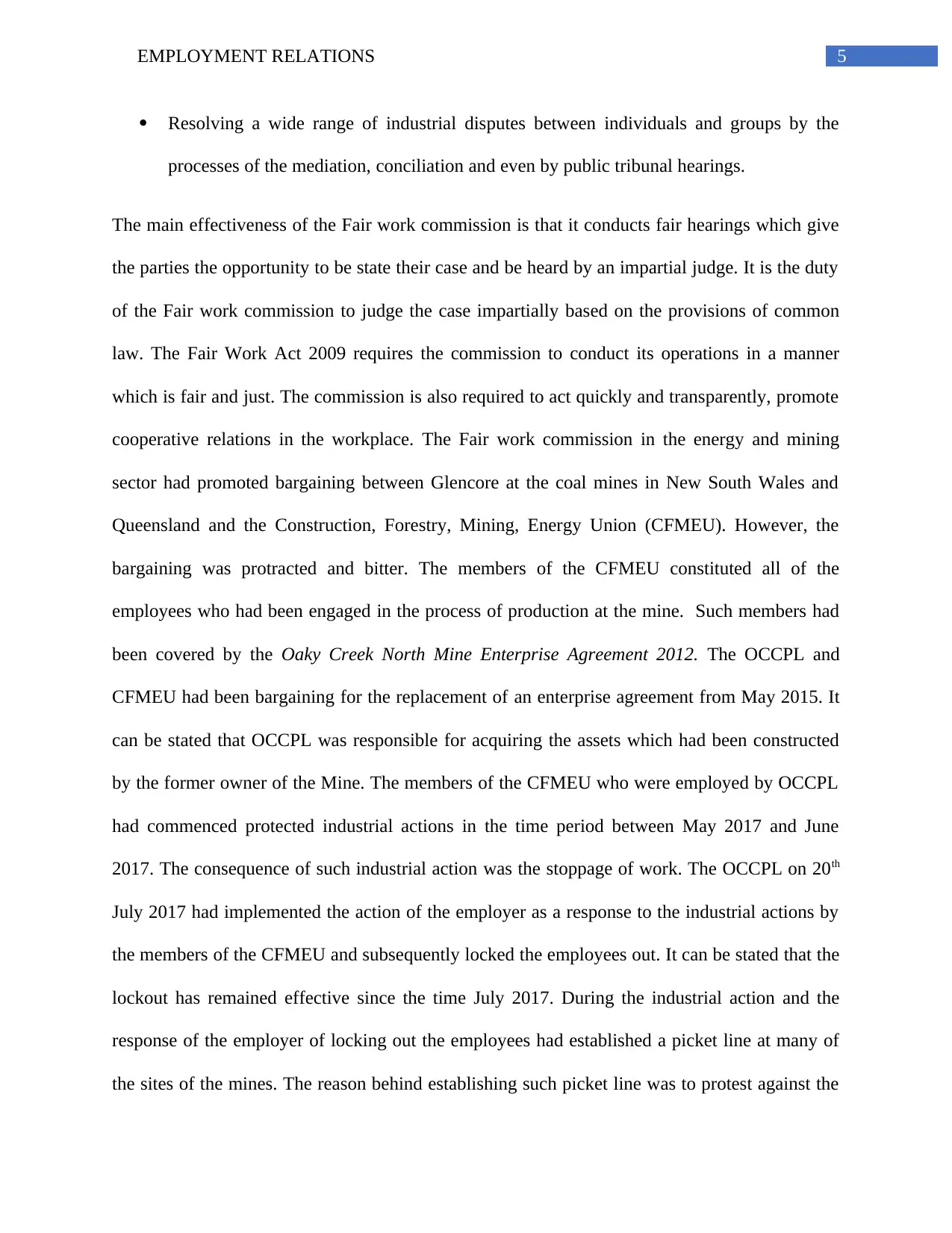
5EMPLOYMENT RELATIONS
Resolving a wide range of industrial disputes between individuals and groups by the
processes of the mediation, conciliation and even by public tribunal hearings.
The main effectiveness of the Fair work commission is that it conducts fair hearings which give
the parties the opportunity to be state their case and be heard by an impartial judge. It is the duty
of the Fair work commission to judge the case impartially based on the provisions of common
law. The Fair Work Act 2009 requires the commission to conduct its operations in a manner
which is fair and just. The commission is also required to act quickly and transparently, promote
cooperative relations in the workplace. The Fair work commission in the energy and mining
sector had promoted bargaining between Glencore at the coal mines in New South Wales and
Queensland and the Construction, Forestry, Mining, Energy Union (CFMEU). However, the
bargaining was protracted and bitter. The members of the CFMEU constituted all of the
employees who had been engaged in the process of production at the mine. Such members had
been covered by the Oaky Creek North Mine Enterprise Agreement 2012. The OCCPL and
CFMEU had been bargaining for the replacement of an enterprise agreement from May 2015. It
can be stated that OCCPL was responsible for acquiring the assets which had been constructed
by the former owner of the Mine. The members of the CFMEU who were employed by OCCPL
had commenced protected industrial actions in the time period between May 2017 and June
2017. The consequence of such industrial action was the stoppage of work. The OCCPL on 20th
July 2017 had implemented the action of the employer as a response to the industrial actions by
the members of the CFMEU and subsequently locked the employees out. It can be stated that the
lockout has remained effective since the time July 2017. During the industrial action and the
response of the employer of locking out the employees had established a picket line at many of
the sites of the mines. The reason behind establishing such picket line was to protest against the
Resolving a wide range of industrial disputes between individuals and groups by the
processes of the mediation, conciliation and even by public tribunal hearings.
The main effectiveness of the Fair work commission is that it conducts fair hearings which give
the parties the opportunity to be state their case and be heard by an impartial judge. It is the duty
of the Fair work commission to judge the case impartially based on the provisions of common
law. The Fair Work Act 2009 requires the commission to conduct its operations in a manner
which is fair and just. The commission is also required to act quickly and transparently, promote
cooperative relations in the workplace. The Fair work commission in the energy and mining
sector had promoted bargaining between Glencore at the coal mines in New South Wales and
Queensland and the Construction, Forestry, Mining, Energy Union (CFMEU). However, the
bargaining was protracted and bitter. The members of the CFMEU constituted all of the
employees who had been engaged in the process of production at the mine. Such members had
been covered by the Oaky Creek North Mine Enterprise Agreement 2012. The OCCPL and
CFMEU had been bargaining for the replacement of an enterprise agreement from May 2015. It
can be stated that OCCPL was responsible for acquiring the assets which had been constructed
by the former owner of the Mine. The members of the CFMEU who were employed by OCCPL
had commenced protected industrial actions in the time period between May 2017 and June
2017. The consequence of such industrial action was the stoppage of work. The OCCPL on 20th
July 2017 had implemented the action of the employer as a response to the industrial actions by
the members of the CFMEU and subsequently locked the employees out. It can be stated that the
lockout has remained effective since the time July 2017. During the industrial action and the
response of the employer of locking out the employees had established a picket line at many of
the sites of the mines. The reason behind establishing such picket line was to protest against the
⊘ This is a preview!⊘
Do you want full access?
Subscribe today to unlock all pages.

Trusted by 1+ million students worldwide
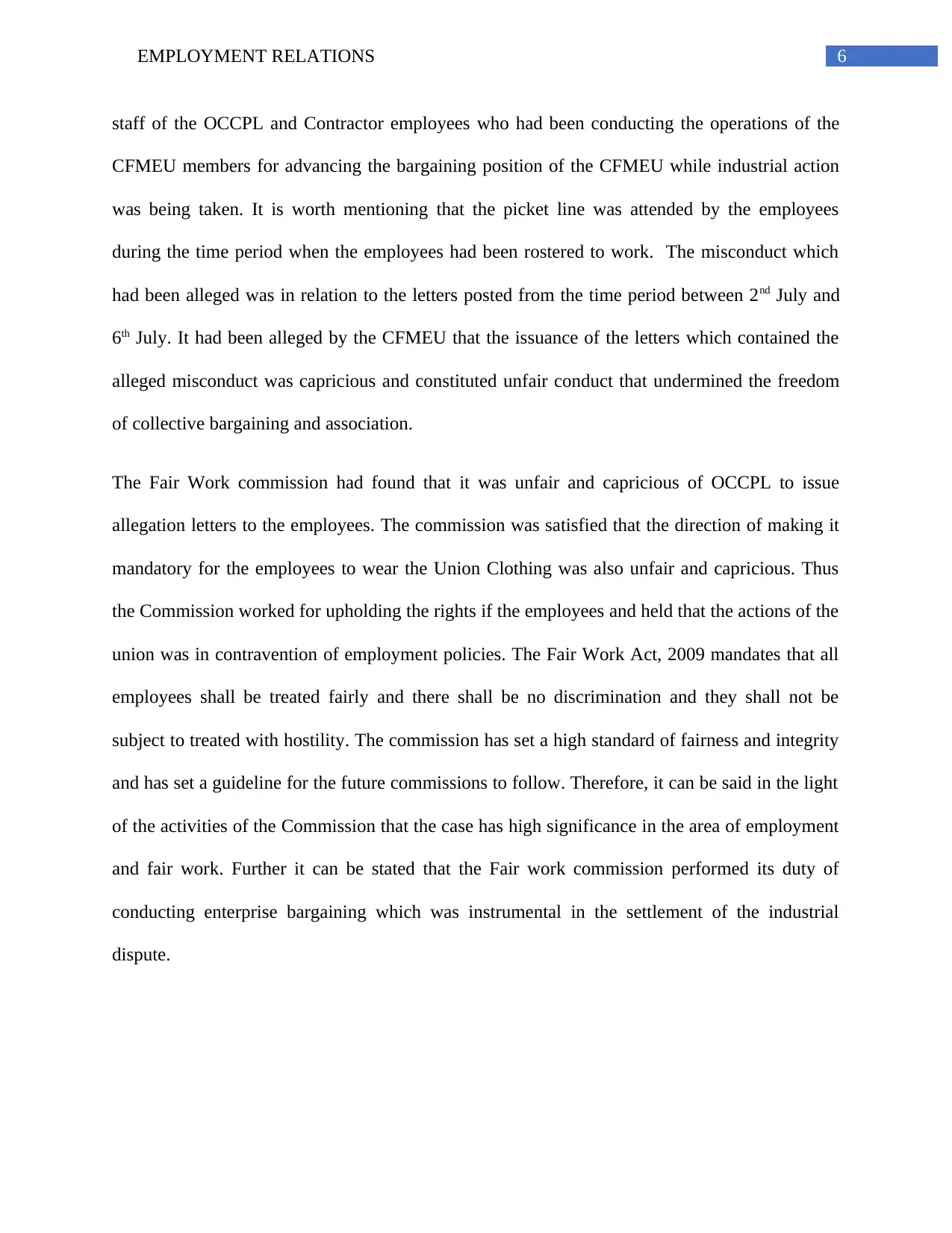
6EMPLOYMENT RELATIONS
staff of the OCCPL and Contractor employees who had been conducting the operations of the
CFMEU members for advancing the bargaining position of the CFMEU while industrial action
was being taken. It is worth mentioning that the picket line was attended by the employees
during the time period when the employees had been rostered to work. The misconduct which
had been alleged was in relation to the letters posted from the time period between 2nd July and
6th July. It had been alleged by the CFMEU that the issuance of the letters which contained the
alleged misconduct was capricious and constituted unfair conduct that undermined the freedom
of collective bargaining and association.
The Fair Work commission had found that it was unfair and capricious of OCCPL to issue
allegation letters to the employees. The commission was satisfied that the direction of making it
mandatory for the employees to wear the Union Clothing was also unfair and capricious. Thus
the Commission worked for upholding the rights if the employees and held that the actions of the
union was in contravention of employment policies. The Fair Work Act, 2009 mandates that all
employees shall be treated fairly and there shall be no discrimination and they shall not be
subject to treated with hostility. The commission has set a high standard of fairness and integrity
and has set a guideline for the future commissions to follow. Therefore, it can be said in the light
of the activities of the Commission that the case has high significance in the area of employment
and fair work. Further it can be stated that the Fair work commission performed its duty of
conducting enterprise bargaining which was instrumental in the settlement of the industrial
dispute.
staff of the OCCPL and Contractor employees who had been conducting the operations of the
CFMEU members for advancing the bargaining position of the CFMEU while industrial action
was being taken. It is worth mentioning that the picket line was attended by the employees
during the time period when the employees had been rostered to work. The misconduct which
had been alleged was in relation to the letters posted from the time period between 2nd July and
6th July. It had been alleged by the CFMEU that the issuance of the letters which contained the
alleged misconduct was capricious and constituted unfair conduct that undermined the freedom
of collective bargaining and association.
The Fair Work commission had found that it was unfair and capricious of OCCPL to issue
allegation letters to the employees. The commission was satisfied that the direction of making it
mandatory for the employees to wear the Union Clothing was also unfair and capricious. Thus
the Commission worked for upholding the rights if the employees and held that the actions of the
union was in contravention of employment policies. The Fair Work Act, 2009 mandates that all
employees shall be treated fairly and there shall be no discrimination and they shall not be
subject to treated with hostility. The commission has set a high standard of fairness and integrity
and has set a guideline for the future commissions to follow. Therefore, it can be said in the light
of the activities of the Commission that the case has high significance in the area of employment
and fair work. Further it can be stated that the Fair work commission performed its duty of
conducting enterprise bargaining which was instrumental in the settlement of the industrial
dispute.
Paraphrase This Document
Need a fresh take? Get an instant paraphrase of this document with our AI Paraphraser
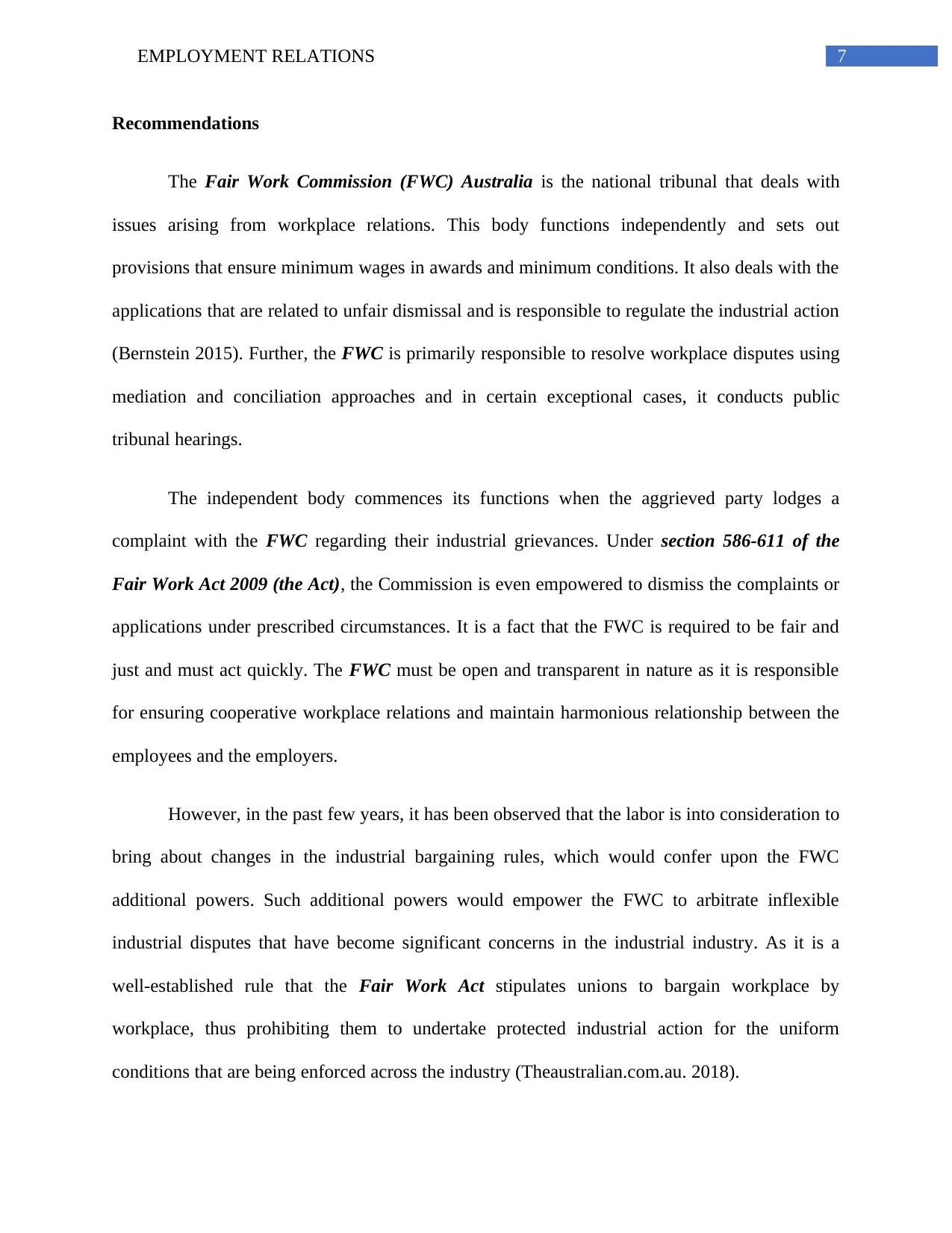
7EMPLOYMENT RELATIONS
Recommendations
The Fair Work Commission (FWC) Australia is the national tribunal that deals with
issues arising from workplace relations. This body functions independently and sets out
provisions that ensure minimum wages in awards and minimum conditions. It also deals with the
applications that are related to unfair dismissal and is responsible to regulate the industrial action
(Bernstein 2015). Further, the FWC is primarily responsible to resolve workplace disputes using
mediation and conciliation approaches and in certain exceptional cases, it conducts public
tribunal hearings.
The independent body commences its functions when the aggrieved party lodges a
complaint with the FWC regarding their industrial grievances. Under section 586-611 of the
Fair Work Act 2009 (the Act), the Commission is even empowered to dismiss the complaints or
applications under prescribed circumstances. It is a fact that the FWC is required to be fair and
just and must act quickly. The FWC must be open and transparent in nature as it is responsible
for ensuring cooperative workplace relations and maintain harmonious relationship between the
employees and the employers.
However, in the past few years, it has been observed that the labor is into consideration to
bring about changes in the industrial bargaining rules, which would confer upon the FWC
additional powers. Such additional powers would empower the FWC to arbitrate inflexible
industrial disputes that have become significant concerns in the industrial industry. As it is a
well-established rule that the Fair Work Act stipulates unions to bargain workplace by
workplace, thus prohibiting them to undertake protected industrial action for the uniform
conditions that are being enforced across the industry (Theaustralian.com.au. 2018).
Recommendations
The Fair Work Commission (FWC) Australia is the national tribunal that deals with
issues arising from workplace relations. This body functions independently and sets out
provisions that ensure minimum wages in awards and minimum conditions. It also deals with the
applications that are related to unfair dismissal and is responsible to regulate the industrial action
(Bernstein 2015). Further, the FWC is primarily responsible to resolve workplace disputes using
mediation and conciliation approaches and in certain exceptional cases, it conducts public
tribunal hearings.
The independent body commences its functions when the aggrieved party lodges a
complaint with the FWC regarding their industrial grievances. Under section 586-611 of the
Fair Work Act 2009 (the Act), the Commission is even empowered to dismiss the complaints or
applications under prescribed circumstances. It is a fact that the FWC is required to be fair and
just and must act quickly. The FWC must be open and transparent in nature as it is responsible
for ensuring cooperative workplace relations and maintain harmonious relationship between the
employees and the employers.
However, in the past few years, it has been observed that the labor is into consideration to
bring about changes in the industrial bargaining rules, which would confer upon the FWC
additional powers. Such additional powers would empower the FWC to arbitrate inflexible
industrial disputes that have become significant concerns in the industrial industry. As it is a
well-established rule that the Fair Work Act stipulates unions to bargain workplace by
workplace, thus prohibiting them to undertake protected industrial action for the uniform
conditions that are being enforced across the industry (Theaustralian.com.au. 2018).
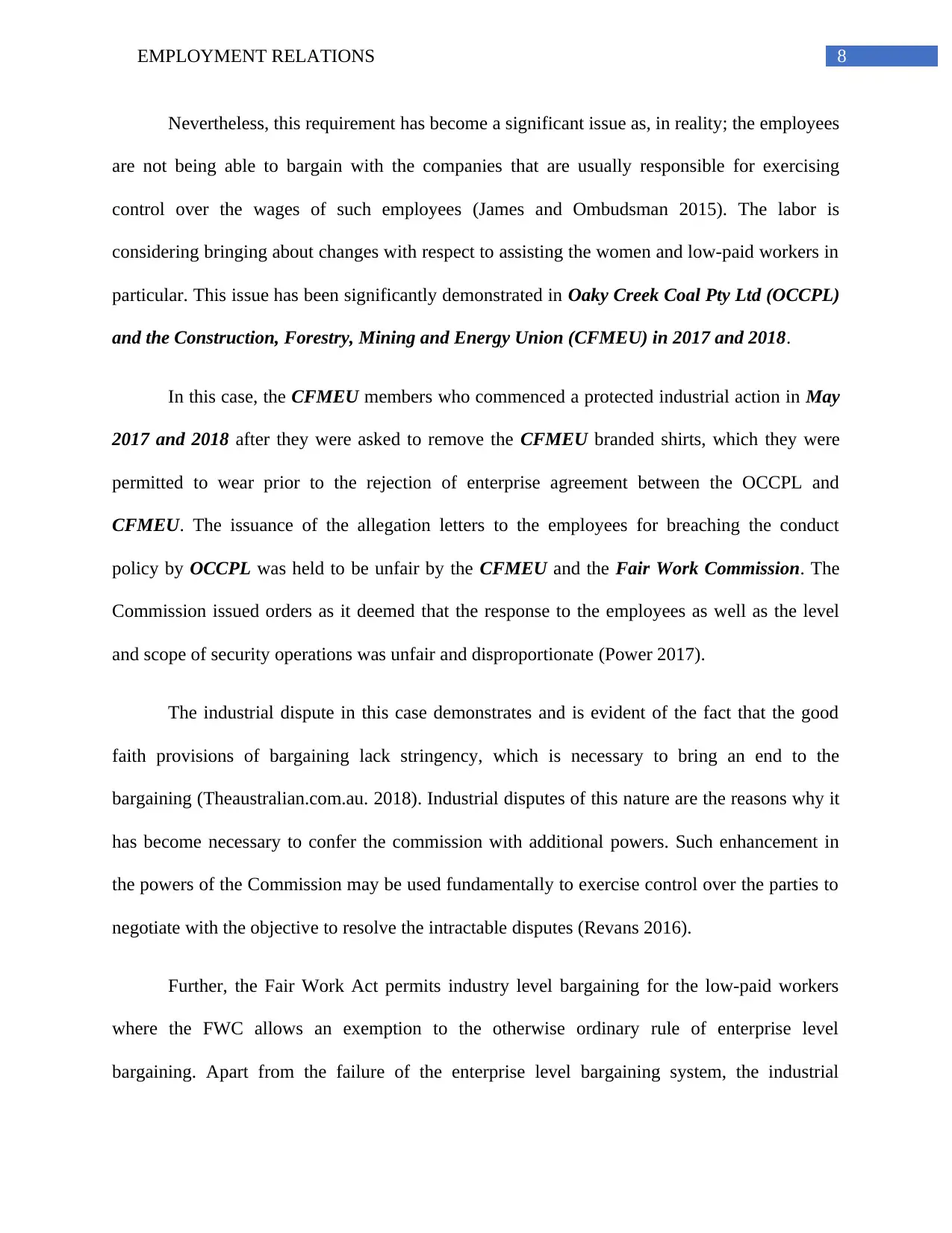
8EMPLOYMENT RELATIONS
Nevertheless, this requirement has become a significant issue as, in reality; the employees
are not being able to bargain with the companies that are usually responsible for exercising
control over the wages of such employees (James and Ombudsman 2015). The labor is
considering bringing about changes with respect to assisting the women and low-paid workers in
particular. This issue has been significantly demonstrated in Oaky Creek Coal Pty Ltd (OCCPL)
and the Construction, Forestry, Mining and Energy Union (CFMEU) in 2017 and 2018.
In this case, the CFMEU members who commenced a protected industrial action in May
2017 and 2018 after they were asked to remove the CFMEU branded shirts, which they were
permitted to wear prior to the rejection of enterprise agreement between the OCCPL and
CFMEU. The issuance of the allegation letters to the employees for breaching the conduct
policy by OCCPL was held to be unfair by the CFMEU and the Fair Work Commission. The
Commission issued orders as it deemed that the response to the employees as well as the level
and scope of security operations was unfair and disproportionate (Power 2017).
The industrial dispute in this case demonstrates and is evident of the fact that the good
faith provisions of bargaining lack stringency, which is necessary to bring an end to the
bargaining (Theaustralian.com.au. 2018). Industrial disputes of this nature are the reasons why it
has become necessary to confer the commission with additional powers. Such enhancement in
the powers of the Commission may be used fundamentally to exercise control over the parties to
negotiate with the objective to resolve the intractable disputes (Revans 2016).
Further, the Fair Work Act permits industry level bargaining for the low-paid workers
where the FWC allows an exemption to the otherwise ordinary rule of enterprise level
bargaining. Apart from the failure of the enterprise level bargaining system, the industrial
Nevertheless, this requirement has become a significant issue as, in reality; the employees
are not being able to bargain with the companies that are usually responsible for exercising
control over the wages of such employees (James and Ombudsman 2015). The labor is
considering bringing about changes with respect to assisting the women and low-paid workers in
particular. This issue has been significantly demonstrated in Oaky Creek Coal Pty Ltd (OCCPL)
and the Construction, Forestry, Mining and Energy Union (CFMEU) in 2017 and 2018.
In this case, the CFMEU members who commenced a protected industrial action in May
2017 and 2018 after they were asked to remove the CFMEU branded shirts, which they were
permitted to wear prior to the rejection of enterprise agreement between the OCCPL and
CFMEU. The issuance of the allegation letters to the employees for breaching the conduct
policy by OCCPL was held to be unfair by the CFMEU and the Fair Work Commission. The
Commission issued orders as it deemed that the response to the employees as well as the level
and scope of security operations was unfair and disproportionate (Power 2017).
The industrial dispute in this case demonstrates and is evident of the fact that the good
faith provisions of bargaining lack stringency, which is necessary to bring an end to the
bargaining (Theaustralian.com.au. 2018). Industrial disputes of this nature are the reasons why it
has become necessary to confer the commission with additional powers. Such enhancement in
the powers of the Commission may be used fundamentally to exercise control over the parties to
negotiate with the objective to resolve the intractable disputes (Revans 2016).
Further, the Fair Work Act permits industry level bargaining for the low-paid workers
where the FWC allows an exemption to the otherwise ordinary rule of enterprise level
bargaining. Apart from the failure of the enterprise level bargaining system, the industrial
⊘ This is a preview!⊘
Do you want full access?
Subscribe today to unlock all pages.

Trusted by 1+ million students worldwide
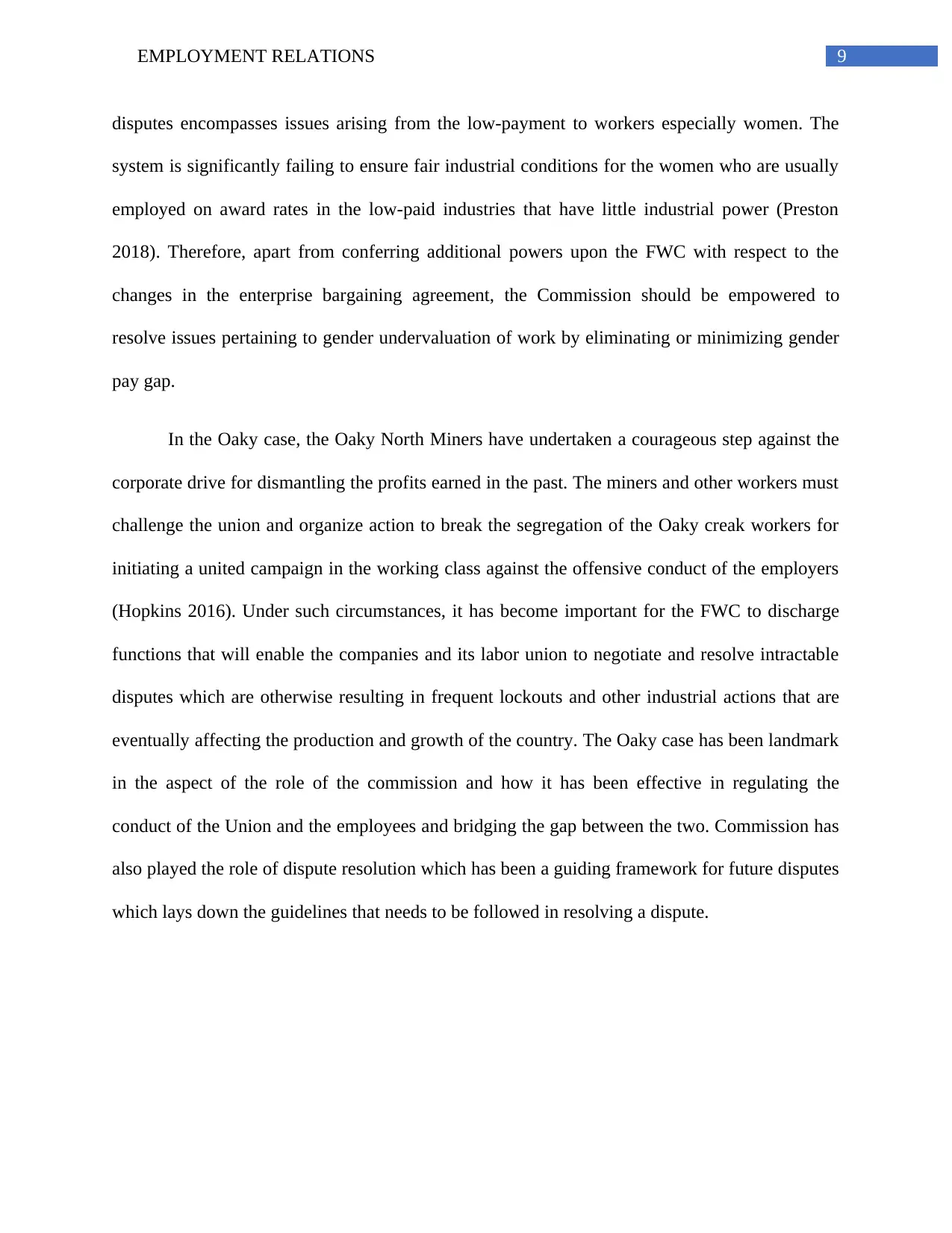
9EMPLOYMENT RELATIONS
disputes encompasses issues arising from the low-payment to workers especially women. The
system is significantly failing to ensure fair industrial conditions for the women who are usually
employed on award rates in the low-paid industries that have little industrial power (Preston
2018). Therefore, apart from conferring additional powers upon the FWC with respect to the
changes in the enterprise bargaining agreement, the Commission should be empowered to
resolve issues pertaining to gender undervaluation of work by eliminating or minimizing gender
pay gap.
In the Oaky case, the Oaky North Miners have undertaken a courageous step against the
corporate drive for dismantling the profits earned in the past. The miners and other workers must
challenge the union and organize action to break the segregation of the Oaky creak workers for
initiating a united campaign in the working class against the offensive conduct of the employers
(Hopkins 2016). Under such circumstances, it has become important for the FWC to discharge
functions that will enable the companies and its labor union to negotiate and resolve intractable
disputes which are otherwise resulting in frequent lockouts and other industrial actions that are
eventually affecting the production and growth of the country. The Oaky case has been landmark
in the aspect of the role of the commission and how it has been effective in regulating the
conduct of the Union and the employees and bridging the gap between the two. Commission has
also played the role of dispute resolution which has been a guiding framework for future disputes
which lays down the guidelines that needs to be followed in resolving a dispute.
disputes encompasses issues arising from the low-payment to workers especially women. The
system is significantly failing to ensure fair industrial conditions for the women who are usually
employed on award rates in the low-paid industries that have little industrial power (Preston
2018). Therefore, apart from conferring additional powers upon the FWC with respect to the
changes in the enterprise bargaining agreement, the Commission should be empowered to
resolve issues pertaining to gender undervaluation of work by eliminating or minimizing gender
pay gap.
In the Oaky case, the Oaky North Miners have undertaken a courageous step against the
corporate drive for dismantling the profits earned in the past. The miners and other workers must
challenge the union and organize action to break the segregation of the Oaky creak workers for
initiating a united campaign in the working class against the offensive conduct of the employers
(Hopkins 2016). Under such circumstances, it has become important for the FWC to discharge
functions that will enable the companies and its labor union to negotiate and resolve intractable
disputes which are otherwise resulting in frequent lockouts and other industrial actions that are
eventually affecting the production and growth of the country. The Oaky case has been landmark
in the aspect of the role of the commission and how it has been effective in regulating the
conduct of the Union and the employees and bridging the gap between the two. Commission has
also played the role of dispute resolution which has been a guiding framework for future disputes
which lays down the guidelines that needs to be followed in resolving a dispute.
Paraphrase This Document
Need a fresh take? Get an instant paraphrase of this document with our AI Paraphraser
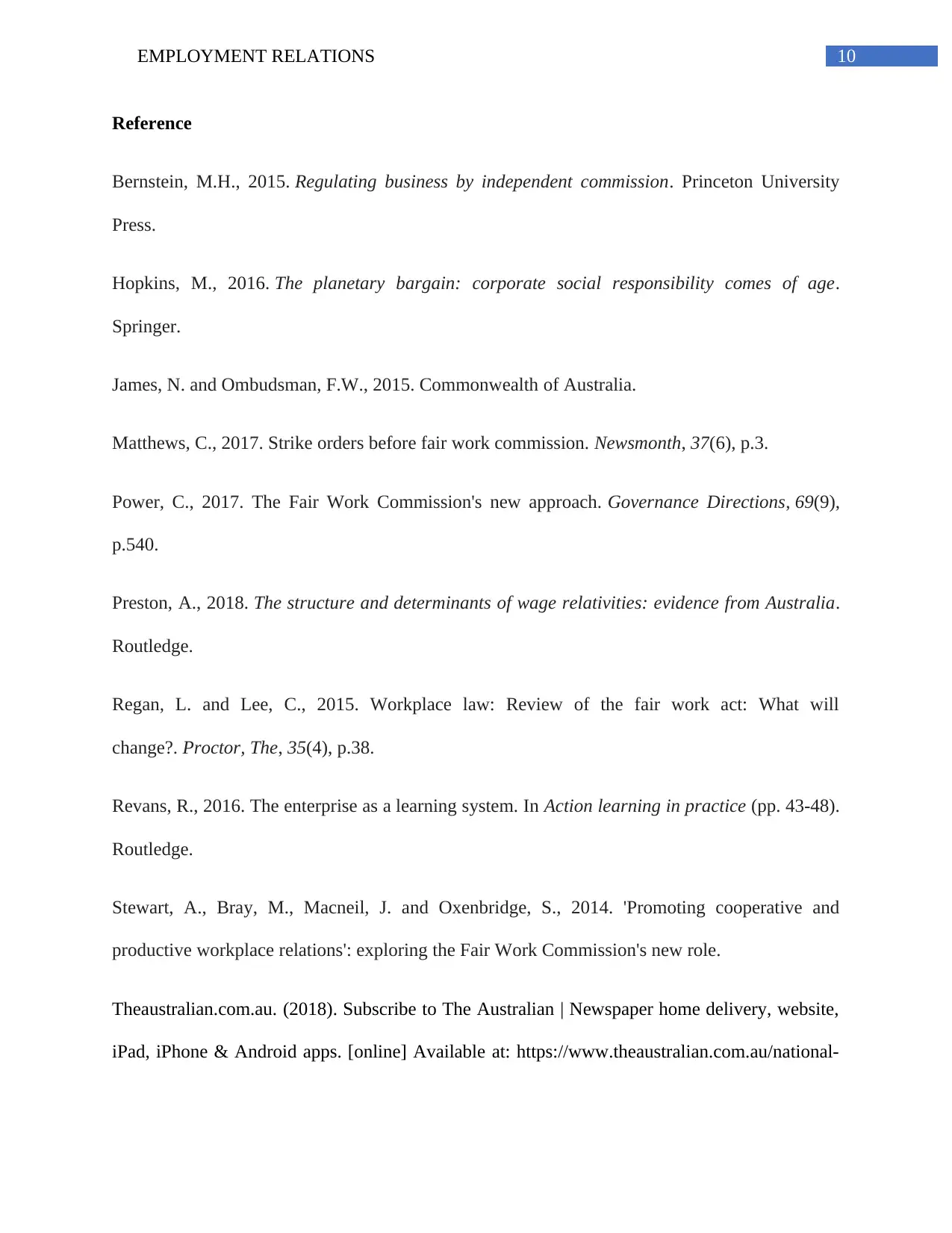
10EMPLOYMENT RELATIONS
Reference
Bernstein, M.H., 2015. Regulating business by independent commission. Princeton University
Press.
Hopkins, M., 2016. The planetary bargain: corporate social responsibility comes of age.
Springer.
James, N. and Ombudsman, F.W., 2015. Commonwealth of Australia.
Matthews, C., 2017. Strike orders before fair work commission. Newsmonth, 37(6), p.3.
Power, C., 2017. The Fair Work Commission's new approach. Governance Directions, 69(9),
p.540.
Preston, A., 2018. The structure and determinants of wage relativities: evidence from Australia.
Routledge.
Regan, L. and Lee, C., 2015. Workplace law: Review of the fair work act: What will
change?. Proctor, The, 35(4), p.38.
Revans, R., 2016. The enterprise as a learning system. In Action learning in practice (pp. 43-48).
Routledge.
Stewart, A., Bray, M., Macneil, J. and Oxenbridge, S., 2014. 'Promoting cooperative and
productive workplace relations': exploring the Fair Work Commission's new role.
Theaustralian.com.au. (2018). Subscribe to The Australian | Newspaper home delivery, website,
iPad, iPhone & Android apps. [online] Available at: https://www.theaustralian.com.au/national-
Reference
Bernstein, M.H., 2015. Regulating business by independent commission. Princeton University
Press.
Hopkins, M., 2016. The planetary bargain: corporate social responsibility comes of age.
Springer.
James, N. and Ombudsman, F.W., 2015. Commonwealth of Australia.
Matthews, C., 2017. Strike orders before fair work commission. Newsmonth, 37(6), p.3.
Power, C., 2017. The Fair Work Commission's new approach. Governance Directions, 69(9),
p.540.
Preston, A., 2018. The structure and determinants of wage relativities: evidence from Australia.
Routledge.
Regan, L. and Lee, C., 2015. Workplace law: Review of the fair work act: What will
change?. Proctor, The, 35(4), p.38.
Revans, R., 2016. The enterprise as a learning system. In Action learning in practice (pp. 43-48).
Routledge.
Stewart, A., Bray, M., Macneil, J. and Oxenbridge, S., 2014. 'Promoting cooperative and
productive workplace relations': exploring the Fair Work Commission's new role.
Theaustralian.com.au. (2018). Subscribe to The Australian | Newspaper home delivery, website,
iPad, iPhone & Android apps. [online] Available at: https://www.theaustralian.com.au/national-
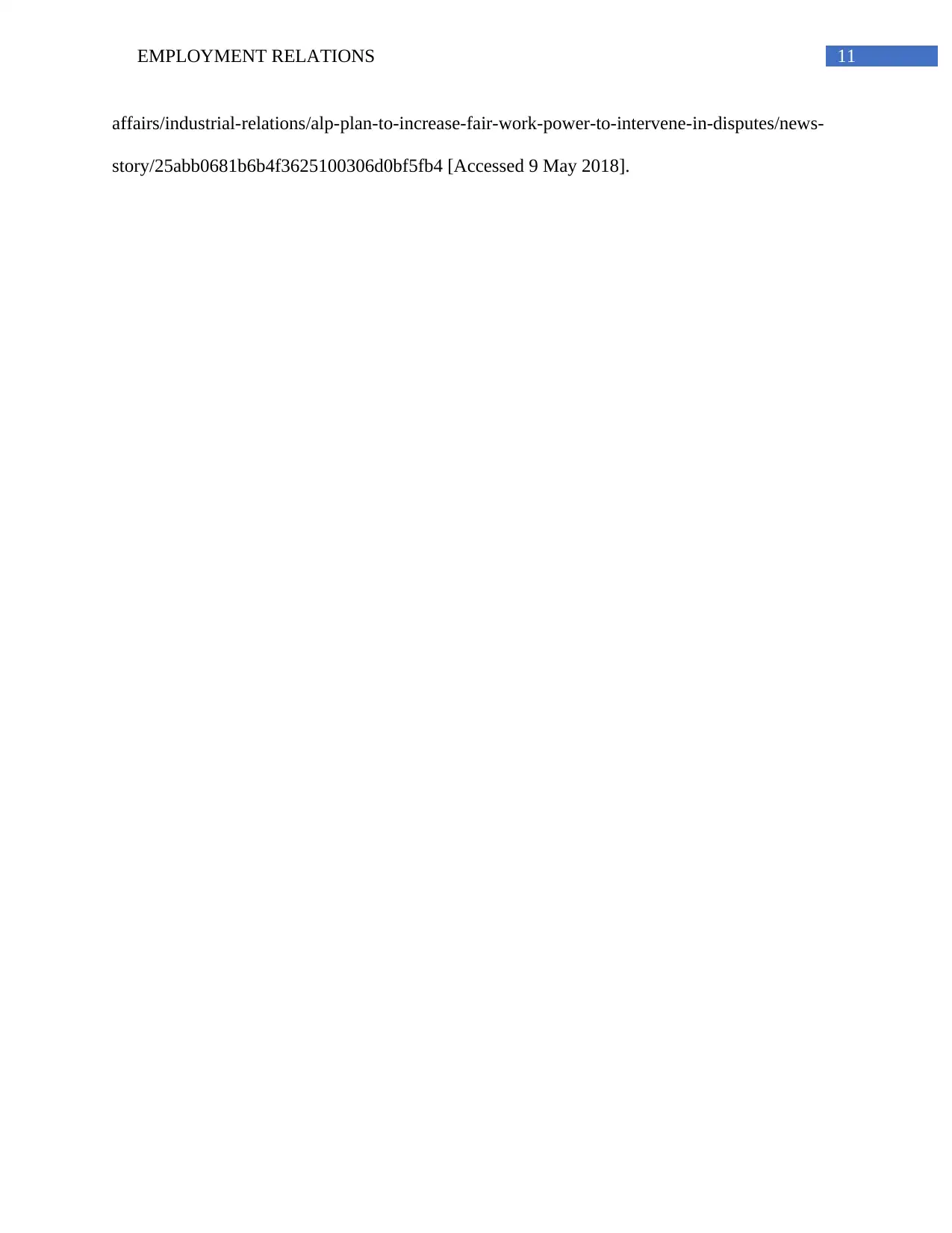
11EMPLOYMENT RELATIONS
affairs/industrial-relations/alp-plan-to-increase-fair-work-power-to-intervene-in-disputes/news-
story/25abb0681b6b4f3625100306d0bf5fb4 [Accessed 9 May 2018].
affairs/industrial-relations/alp-plan-to-increase-fair-work-power-to-intervene-in-disputes/news-
story/25abb0681b6b4f3625100306d0bf5fb4 [Accessed 9 May 2018].
⊘ This is a preview!⊘
Do you want full access?
Subscribe today to unlock all pages.

Trusted by 1+ million students worldwide
1 out of 12
Related Documents
Your All-in-One AI-Powered Toolkit for Academic Success.
+13062052269
info@desklib.com
Available 24*7 on WhatsApp / Email
![[object Object]](/_next/static/media/star-bottom.7253800d.svg)
Unlock your academic potential
Copyright © 2020–2025 A2Z Services. All Rights Reserved. Developed and managed by ZUCOL.





